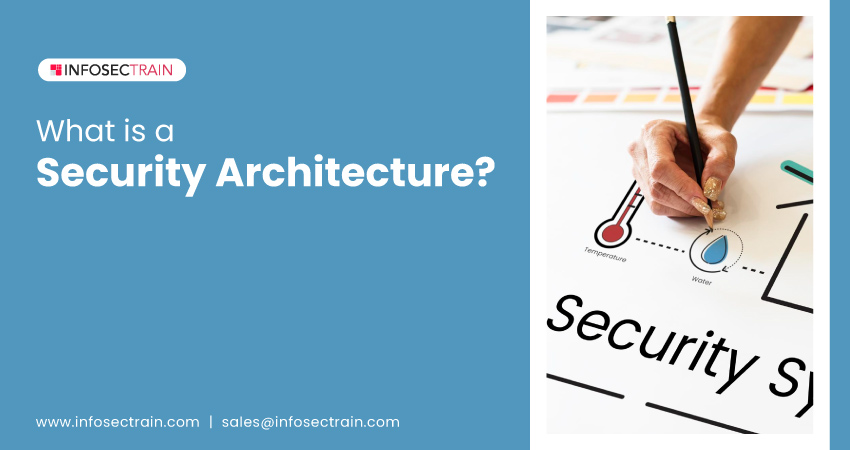What is a Security Architecture?
As cyber-attacks are increasingly growing, the need for strong security measures to protect organizations is not deniable. A cyber-breach can cost the organization a lot of money. So, what can we do to stop these security vulnerabilities? This is where strong cyber security architecture comes in the scenario, which can reduce these cyber security threats.

Table of Contents
What is Security Architecture?
The Purpose of Security Architecture
Elements of Security Architecture
Security Architecture Frameworks Examples
Benefits of Cyber Security Architecture
Phases in the Security Architecture Process
What is Security Architecture?
When discussing security architecture, security applications and tools such as firewalls, antivirus programs, anti-malware software, etc., come to mind first. However, security architecture encompasses all of these elements. A security architecture is a collection of models, methods, and security principles that work together to keep the organization secure from cyber attacks.
Through security architecture, an organization’s needs are interpreted into executable security needs. Similar to the examination of a property’s climate, soil type, topography, and client preference in construction architecture, a security architect must understand the network, firewalls, defenses, and detection systems, among other factors.
In the security architecture, the design principles are typically specified, whereas the detailed security control specifications are typically recorded in a separate file. The system architecture can be thought of as a plan that includes a structure and figures out how the parts of the structure connect to each other.
The Purpose of Security Architecture
Typically, security architectures have the same goal to protect the organization from cyber damage. Security Architects will frequently try to embed individuals in the business to understand what makes users and the people unique. They will speak with the executives and staff in an effort to understand the unique business objectives, system requirements, customer demands, and other crucial factors.
Elements of Security Architecture
Instead of being independent systems, the security architecture is linked to current security policies and guidelines. Firewalls, antivirus/malware software, threat intelligence platforms, and other security tools and applications that defend the organization’s network are thus included as components of security architectures. A strong security architecture combines three elements: people, processes, and tools.
Security Architecture Frameworks Examples
Frameworks give security architects a set of rules to follow. A security architecture framework is a collection of consistent rules and guidelines for putting different levels of a business’s security architecture into place. Organizations may choose to make their own frameworks by putting together global standards like
- TOGAF: The Open Group Architecture Framework (TOGAF) assists an organization in figuring out what problems it needs to fix in its security infrastructure. Its main focus is on the organization’s goal and scope and the early stages of security architecture.
- SABSA: Sherwood Applied Business Security Architecture (SABSA) is a framework that is based on policies. SABSA’s objective is to ensure that after security services have been designed, they are presented and assisted as an essential component of the enterprise’s IT management.
- OSA: The Open Security Architecture (OSA) is a technical and operational security control framework.
Benefits of Cyber Security Architecture
The first and most obvious benefit of better security is that security breaches are less likely to happen. Therefore, the following are some benefits of cyber security architecture:
- Reduces security vulnerabilities: Organizations today require a robust security architecture framework to defend their most valuable information assets. Users can significantly lower the likelihood of a successful system attack by strengthening the security architecture to tight known vulnerabilities.
- Proactive security steps save money: It costs a significant amount of money to find and fix security vulnerabilities. Integrating security at all stages of product development can assist in lowering the risk of errors and omissions.
- Integrate supervisory stages in case of a breach: The penalties for a cyber security breach vary from place to place. However, one thing is common: the more an organization tries to reduce risk and close gaps, the better the outcome may be if attacked.
Phases in the Security Architecture Process
The following are the essential phases of the security architecture procedure:
- Architecture risk assessment: Analyze how significant corporate assets affect the business and the chances and effects of security vulnerabilities and threats.
- Security architecture and design: The design and layout of security services allow enterprises to meet their overall risk goals.
- Implementation: Services and methods for security are set up, run, and controlled.
- Operation and monitoring: Processes that happen every day, like threat and vulnerability management and threat management.
Final Thoughts
In this age of technology, you must understand how important it is to protect your organization from cyber security risks. Security architecture is a way to protect digital assets and lower the risk of cyber attacks.
Cyberattacks are the fastest-growing type of illicit activity globally, so protecting your company or yourself from these threats is crucial. In today’s competitive professional environment, possessing the necessary cybersecurity knowledge also confers a significant advantage. InfosecTrain offers the most rigorous professional cybersecurity and cloud certification training to anyone seeking to advance their career.






 1800-843-7890 (India)
1800-843-7890 (India)